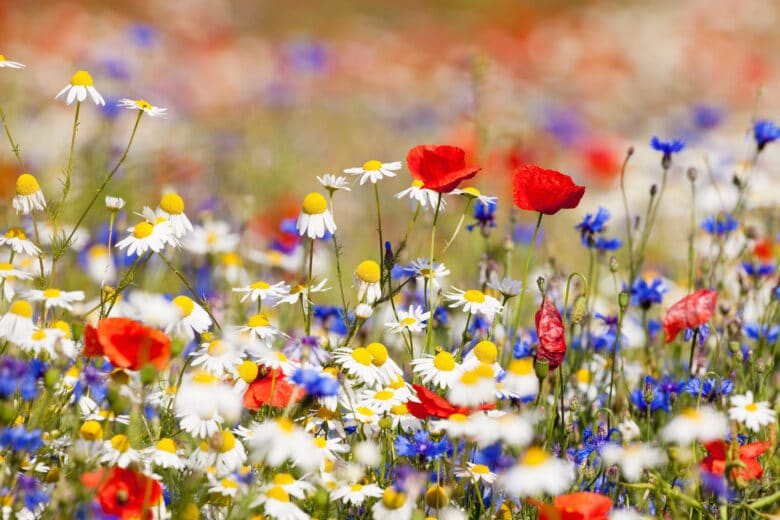
Spring is the favorite season for nature lovers. They wait impatiently in the long cold and gray months of the year for the first green to finally start sprouting again. When the time finally comes, the blossoming nature not only invites you to go for walks and hikes, but also to take photos – when else do fragile green plants break through the ground so gracefully and immerse the world so clearly in a complex sea of colors of the most diverse flowers and blossoms? Nature photography makes it possible to capture this beauty and diversity of nature. Whether in the forest, in your own garden or elsewhere – nature offers endless motifs for impressive photos in spring. To make your spring nature photos even better, we have put together some valuable tips and tricks for you.
The equipment is crucial
To take good nature photos, you need a good camera. However, this doesn’t mean that spring photography has to be reserved for the financial elite: An expensive SLR camera such as Canon’s premium EOS 250 Digital model is not essential; you can also take strong photos with a high-quality compact camera such as the 4K Digital Camera or a current cell phone. In any case, make sure that your camera has a good resolution so that you can also capture details in nature. A tripod(which is now also available for cell phones) is also helpful to avoid blurred images. This is where it gets professional – and the journey from the occasional photo to the planned motif photo begins.
If you’re heading out into nature to take good photos, you should have a camera, a flexible tripod and all the other items you need with you. Depending on the camera you choose, this includes spare batteries and a memory card with sufficient space. There are also suitable lenses. Remember that you need to be equipped for very different situations. If you want to capture a flower with all its details, you need a macro lens. If, on the other hand, you want to capture an entire forest landscape, you need a wide-angle lens. We recommend that beginners in particular go out with a lens that can be adjusted in the range from 18 to 55 millimetres. You’ll be well equipped for most situations.
The light makes all the difference

The right light is crucial for successful nature photos. It is best to take photos in the morning or evening hours when the light is softer and warmer. The so-called golden hour, when most photographers are out and about, is the hour directly after sunrise and directly before sunset. You should avoid the midday sun, however, as this can lead to harsh shadows and overexposed photos. Overall, it can be said that exposure outdoors is much more challenging than indoors – after all, you are always confronted with clouds and other unpredictable factors. Experts therefore recommend trying out a lot at first. Ultimately, you need to develop a feeling for when the exposure is acceptable – and this only comes as a result of prolonged experience. Nevertheless, we can give you one important tip: Never delete a photo until you have looked at it at home! The lighting conditions outdoors can quickly make a photo appear unsuccessful, even though it is actually ideally exposed. So check your photos under good lighting conditions and not immediately after taking them.
Test out perspectives
Experiment with different perspectives to take particularly exciting nature photos. You will already know this from your reception position: A single subject can look completely different in different shots. This is usually due to the position from which it was photographed. A tree photographed from the ground looks gigantic; however, if you stand upright and take a picture of it from a distance, it almost completely loses its majestic appearance. The same applies to other plant motifs that you will encounter in spring. So try yourself out! Stand at the same eye level as your subject to achieve a natural and authentic effect. Or try out unusual angles, for example by lying on the ground or photographing from above.
Intervene as little as possible

Try to make your nature photos as natural as possible without interfering too much with nature. Avoid disturbing plants or animals to get the perfect photo. Instead, respect nature and follow the rules of nature conservation. If you see yourself as an observer, you will be able to take impressive photos without leaving behind a field of debris. In particular, uprooting plants or disturbing animals should be taboos that you do not break. Otherwise, you will find yourself in a paradox that haunts many nature lovers: You admire nature for its beauty, want to capture it – and destroy it through this very act.
However, this does not mean that every intervention is forbidden. If you want to capture a single flower, for example, you will hardly be able to do so without shielding your subject a little. However, there are more and less invasive options. If you choose the latter, nature remains intact. Gentle methods include gently bending other plants to the side with the help of paper or small sticks. This allows a clear view of your subject without harming the surrounding fauna.
Composition and co
An important point that this touches on is image composition. If you want to produce high-quality shots, you should make sure that your main subject is the clear focus of the photo. In addition to the choice of lens and perspective, it is also important to check the arrangement of the image: Are there any distracting elements? Is the subject centered? Are there any distractingly large edges? Also observe the rule of thirds and the golden ratio.
The regulation of the depth of field of the image is also relevant and closely linked to the image composition. It goes without saying that your shot should be sharp. But how sharp exactly? Especially when shooting small subjects, such as a flower with intricate details, the greatest possible depth of field is required. You can achieve this with a long exposure and by using the smallest possible aperture. This in turn is made possible by using a tripod – because only then is it realistically possible to implement the described setup without major problems. You can also try out aperture priority mode to achieve more depth of field and therefore more detailed shots.
Be patient
Nature photography requires patience and perseverance – as the previous explanations have already indicated. If you want to take strong photos, you have to wait for the perfect time of day and be prepared for all kinds of disturbances. A single cloud can ruin the exposure, a small gust of wind can push the subject out of focus. So be prepared for the fact that taking photos in the springtime wild can be a game of patience – and that explicitly includes the search for suitable motifs. There is no shortage of blooming nature in spring, but that doesn’t mean you’ll find the perfect subject on every street corner. But don’t worry: patience pays off in the end!



